The coaching philosophies in football are the things that differentiate them and made the game look more complicated and, finally, more interesting. Every single one of us has their favourite style of play, and on-field coaching is the main way to realize your idea into material form.
Controlling possession is one of the most popular gameplans and it is often used from the ‘bigger’ teams who want to be all over the game, and to be in control of every detail happening throughout the 90 minutes. Also, my opinion is that this style could be of great importance for all of the teams, no matter what is their initial gameplan, because the security on the ball is a key factor in the modern game.
This coaching tactical analysis will show you the three drills that could help you train the control possession style, along with some other segments of the game that could fit your tactics.
Overview
Controlling possession is the philosophy that is based on short passing and good positional play. The key idea is to create numerical advantages on restricted areas of the pitch in order to progress with your actions by always having an available option to pass. The drills we have lined up are commonly based on the „keeping-the-ball“ in surplus scenarios, along with the counter-pressing and defensive transitions parts which are closely related to the possessional type of play.
In this analysis, we will break down the drills that could be used in the main part of the practice and that help players feel more comfortable with the ball, but force them to maintain the structure after the ball is lost. Also, the communication between the players is of great importance when playing this way, so it should be encouraged throughout those sessions.
Arigo Sacchi’s double rondo
The first drill we are going to talk about was created by the legendary Italian coach Arigo Sacchi, back in his days in AC Milan. The setup of the session is quite simple – a bigger rectangle with the 40 meters in length and 25-30 meters in width, with a smaller square in the centre of it that is shaped 12×12 meters. The number of players included for the initial setup is ten, but it could vary depending on the number of players you have in training, and throughout the variations, you’re making to the exercise.
First thing you do is the asymmetrical division of roles as you create two teams – Red and Blue players as it will be addressed from now on – with Blues having six players in their team, and Reds having four. The game starts with Reds in possession in the central square, where the four of them play 4v2 rondo against the two Blues who are chasing the ball. The number of touches for Reds is limited and it can change depending on what is your idea, but the initial task is for them to play a two-touch game. They get the point whenever they come up with 15 passes, so the game has its competitive character.

Here we can see the visual of the game with Reds playing the rondo, and the two of the Blues trying to win the ball. Whenever the ball is lost it comes to the switch in possession, but in the bigger area of the two, now making blues the numerical superior side who try to keep the ball in the 6v4 scenario. The task for them is also to get to the 15 passes, but playing the three-touch game, which can and should be reduced to the two and one-touch throughout the series.

When Reds lose the ball, it is important for them to switch in the state of mind for counter-pressing, but from a numerical inferior position. They need to cooperate and talk to each other in order to create the best possible defensive structure which will make it difficult for surplus opposition to pass through. The aggression of the defending players is one of the key factors in out of possession game, but along with compactness and teamwork.
Once again, when it comes to another possession switch, teams go back to their initial positions, with the other two Blues in the square rondo chasing for the ball. The two of them also need to communicate, and to find the best balance between pressing the player with the ball and closing down the in-between passing lane. It is encouraged that the Red players are all from the same branch of the team – four midfielders (with same or different roles in the team, defensive four, four attackers, etc.), whilst the six Blue players could be the mixture from two lines of the team, which will help them build understanding.
This drill can have its variations in terms of the number of players, but also in terms of concept. The more complex way to exercise is to have goalkeepers on both ends of the rectangle and to use them when the initial 4v2 rondo is broken. The tasks remain the same in the square (they can be modified a little, for example, reduced number of touches, or passes to win a point), but the main change happens in the 6v4 game where the key modification is related to the directness of the play.

When the Blues get the ball, they are encouraged to pass the ball faster, with the add on of finishing. They need to produce seven passes between themselves – not 15 anymore – and after the seventh pass, they can go for a shot on whichever goal they want. Also, they don’t need to hurry to shot right after the seventh pass, but it is wanted for their side to play a more direct game when goalies are in their places. The field size can also be restricted, if you want to encourage your players to think faster in smaller areas and if you want to speed up the game.

Defensive tasks remain the same for Reds when the initial rondo breaks down, and they need to defend tightly and in a well-organised shape, but also to be aware of defending both goals at the same time. The drill can be executed with a lot more or fewer players, depending on the situation you have on the pitch, and can be useful for control possession as much as for communication between the players, and counter-pressing coaching.
Three-colours possession
This exercise is the modification of a classical two side possession games in the restricted area, with the clear intention of improving the on-ball security for your players. It is happening in the marked 25x15m box with cones at the half of each “length” line and at the end of them, marking the operational space for players on the sidelines. Game is played by three teams made of five players, with every team having three of them inside the rectangle, and two outside of it in the marked areas, as you can see in the picture below.
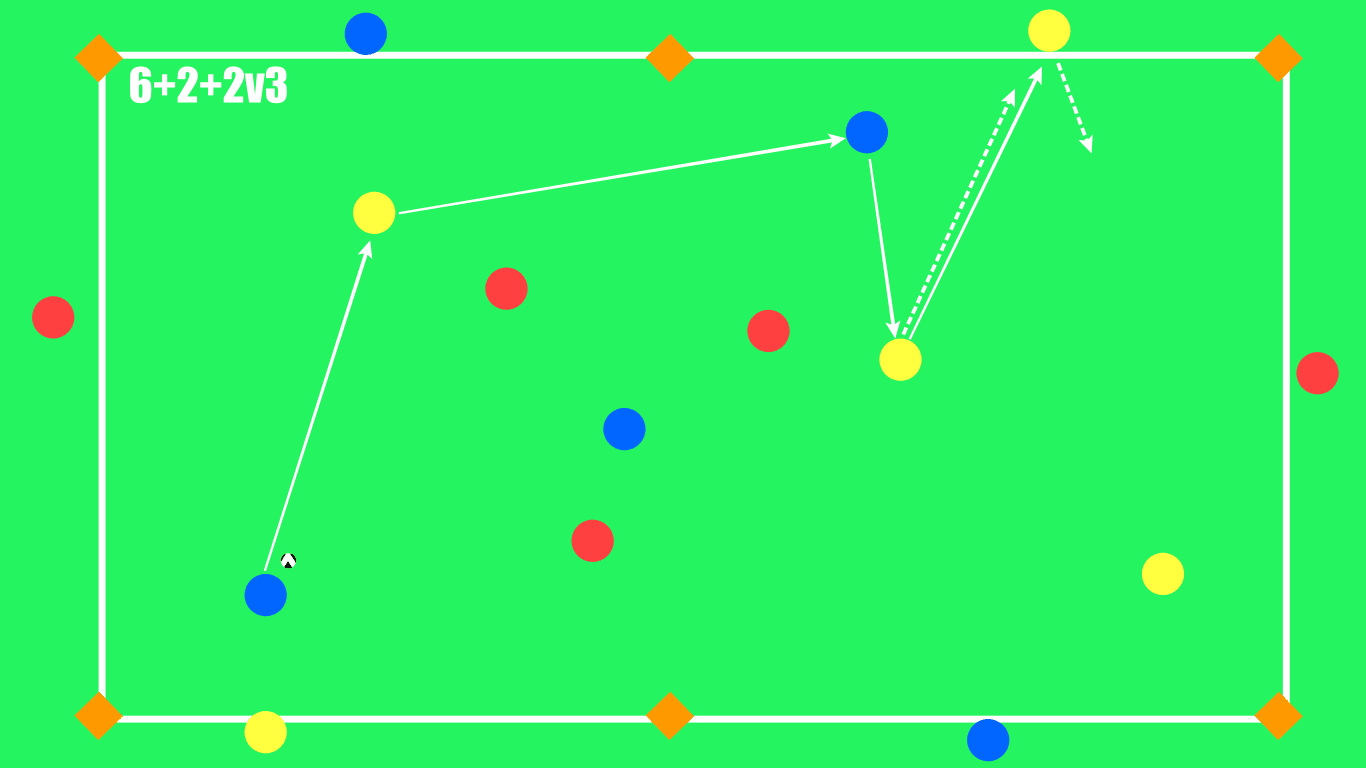
Here is the initial setup of the game, along with some tasks that will be explained further in the analysis. We have three teams – Blues, Reds and Yellows, which are all set inside and outside the box, with outside players from the same team being positioned diagonally to each other. The main task is for the inside players to play „two colours against one“ three-touch (later reduced to two-touch and one-touch) game in a 6+2+2v3 setup.
For example, we have Reds defending and trying to win the ball, while Blues and Yellows are in possession. On the first glance it looks like an easy possession for the numerical superior teams, since they also have help from their players outside the box, but as the game intensifies, it gets more and more difficult for them to keep the ball. Also, the fact that the field is small makes it difficult and forces players to think faster. To cut down the easy part, Blues can only pass to the Blues outside the box, taking their spot after they sent the pass, whilst the outside player enters the action after he received the ball. Outside players have the same number of touches as the players inside the field.
When Reds win the ball, their team keeps possession with the team they haven’t won the ball from – for eg. if they get the ball from Blues, Blues start trying to win the ball, and Yellows are still the possession team. The main factors of the game for in-possession teams are fast-thinking and security on the ball. They have various options since they are in a surplus situation all the time, but the small area of the play leaves a very small amount of free spaces so their decisions need to be on a very high level and perfectly timed.
This drill goes into modifications in terms of defending team, which complicates the game even more for both in and out of possession sides. The main change in the variation is the sideline player entering the box when his team losses possession, which creates 6+2+2v4 setup in the box.
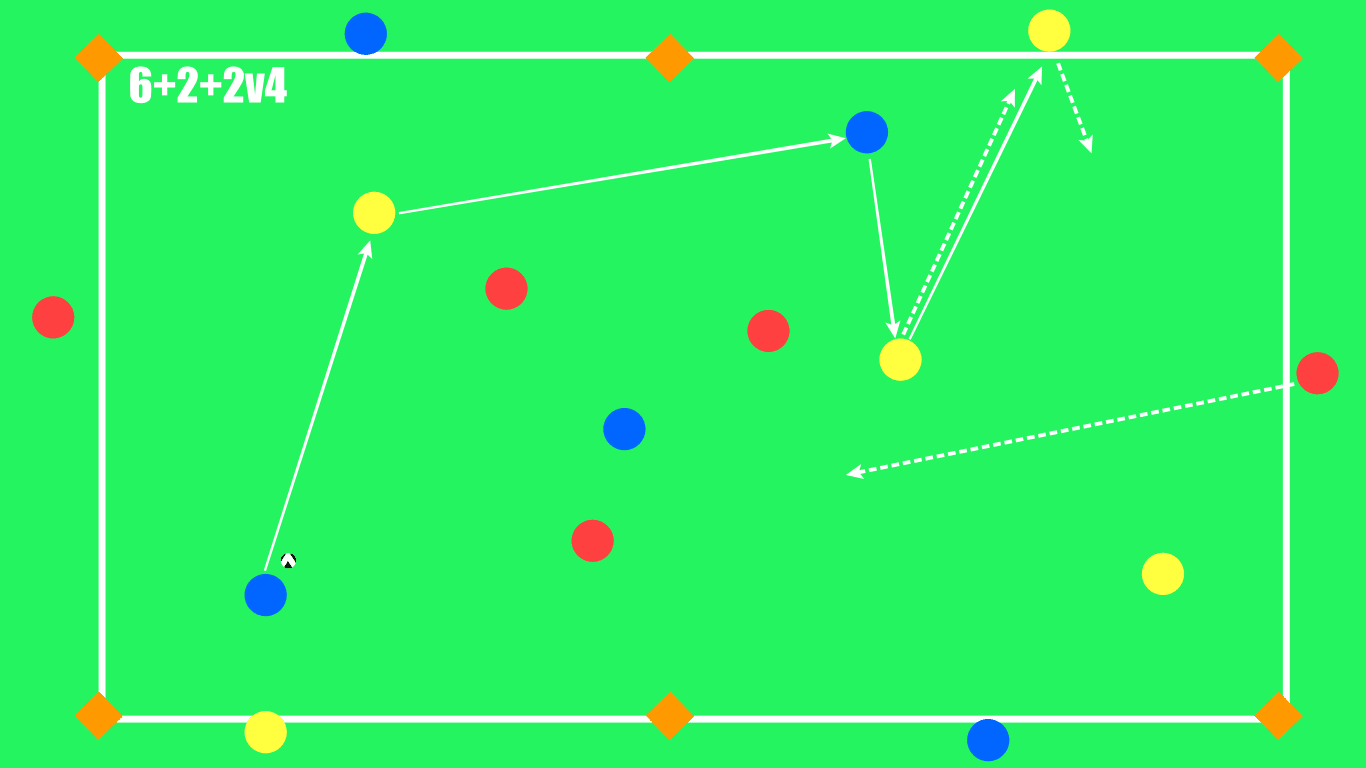
In the picture above, we can see the modification of the game with Red player entering the pitch in order to make it more complex for the players with the ball to pass through the defending team. Once again, Reds need to communicate and to keep the shape in order to disrupt the opposition’s passing game. Tasks for the possession side remain the same, with potential changes in terms of touches, and „no long ball“ rule.
When Reds win the ball, one of their players needs to exit the pitch as fast as possible since they have one more player in the box, and the player from the team that has lost the ball is free to enter in order to help his teammates regain the possession.
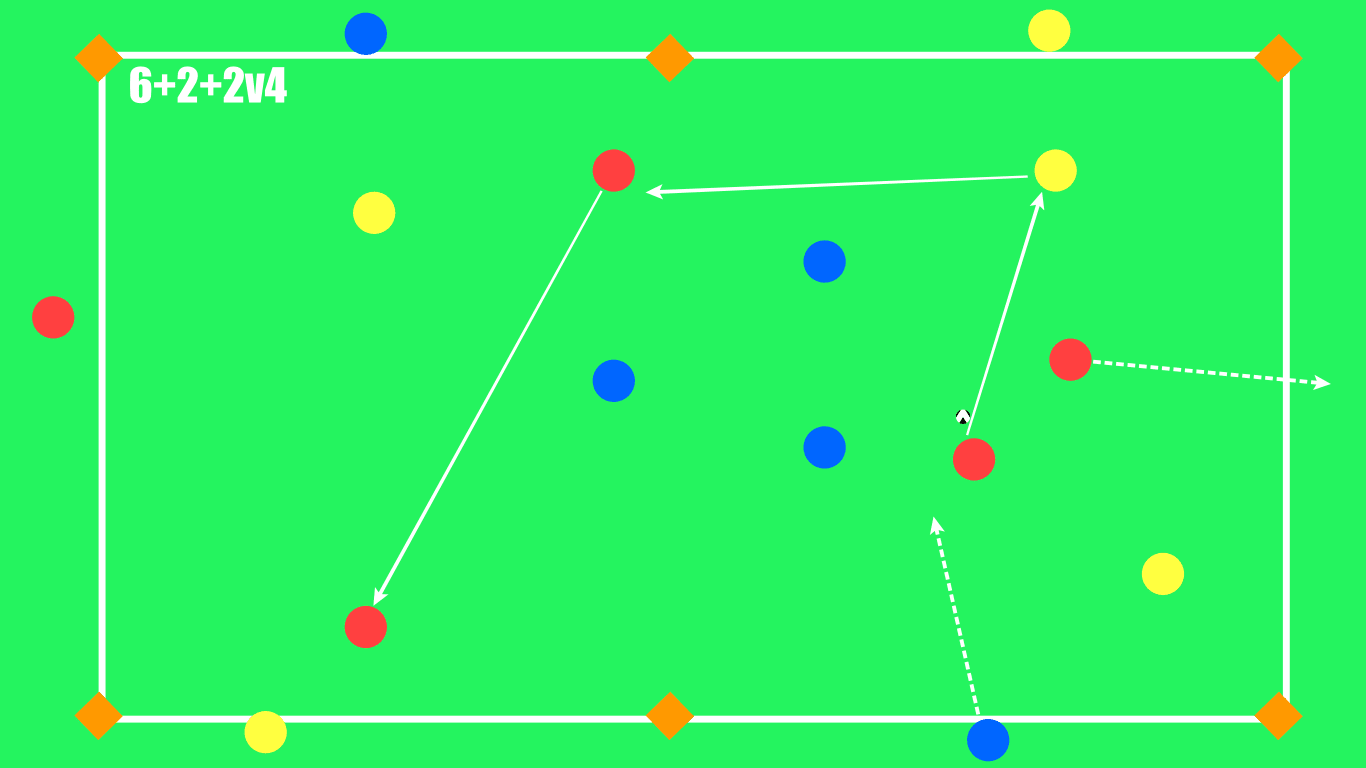
It is encouraged to play in the small field, as it is mentioned earlier in the analysis, in order to train your players to think faster and to become more comfortable under pressure. Also, the counter-pressing segment remains as important as it was in the previous drill, with aggression and communication as its key parts.
Offensive surplus play
The third drill is the best of mentioned for playing it in the main part of the training as it is based on the patterns used in the regular game. First of all, it is set on one half of the pitch, with a regular goal on one side, and two small ones on the opposite, with players participating in the two-way game.
One team is made of six defenders (it is good to have for eg. the whole defensive line made of four and two midfielders, or five defenders and a defensive midfielder, etc.) and a goalkeeper, who try to defend the big goal, whilst the other side is filled with seven attackers (this team should be made out of mixture made of midfielders and forwards).
Teams are encouraged to play a ‘free game’, with some restrictions in terms of touches given, shots coming only out of the first-touch, after crosses, etc. The main idea is that the attackers – Red team – always have numerical superiority over the defenders – Blue team – which can be of great importance for them to become more secure on the ball. They will always have a free player, a possible passing option, but with the task of circling the block if the situation is not open – not to force forward passes.
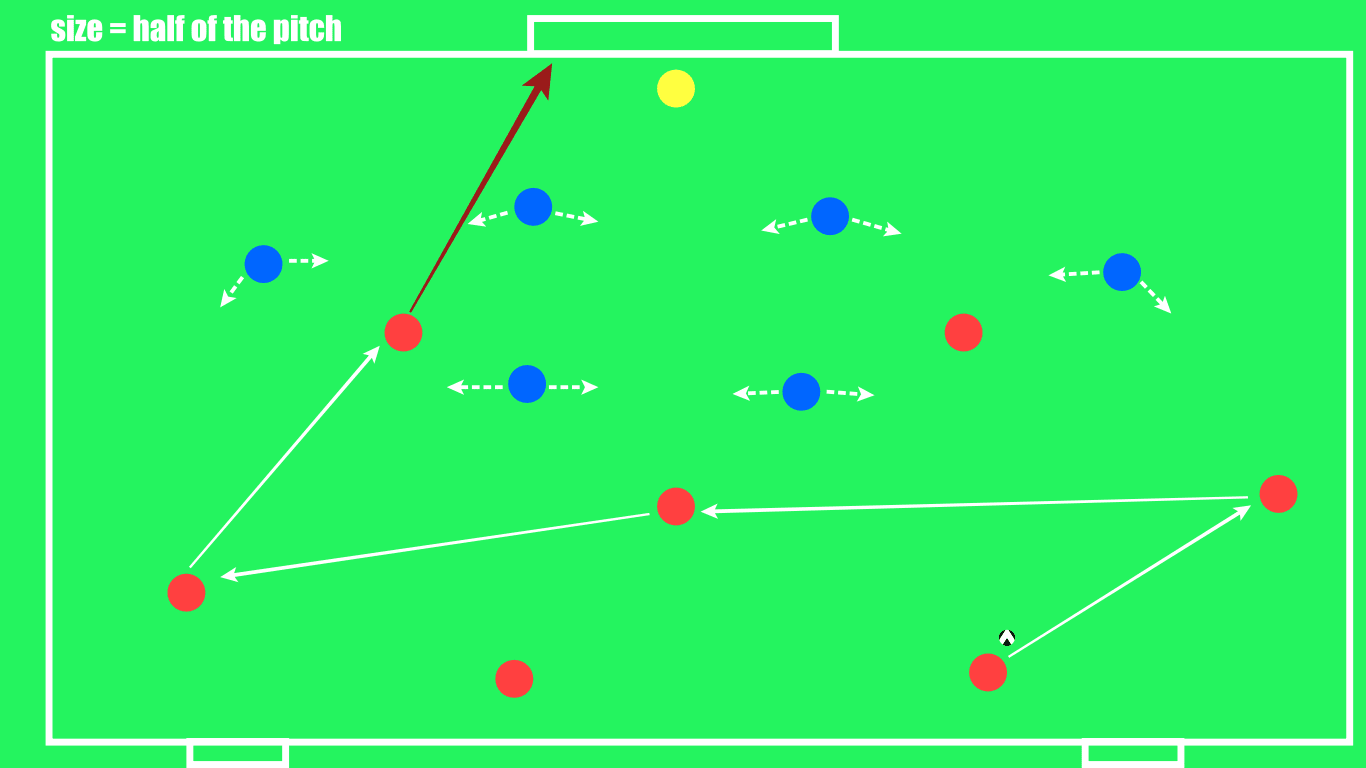
Reds are working on their control possession, whilst the Blues are encouraged to move together and to communicate, trying to keep the discipline in the block and disable opposition of coming into goal-scoring opportunities. The attacking team can go for an attempt whenever they see its fit, but with the initial intention of securing the possession and breaking line by line with their passing, and scoring out of clear situations.
When the attackers lose the ball, task Blues have is to get to the two small goals in a short time as possible, but with no long balls. There lies the idea of „brave possession“, where the numerical inferior team doesn’t step away from the passing game even though they have a player deficit in some area of the pitch. That makes them think more, and think better under pressure, trying to find an optimal solution, and not just give the ball back to the opposition. They need to base their counters on the direct play, tend to move forward, but not at all costs, so they’ll also train the possessional skills.
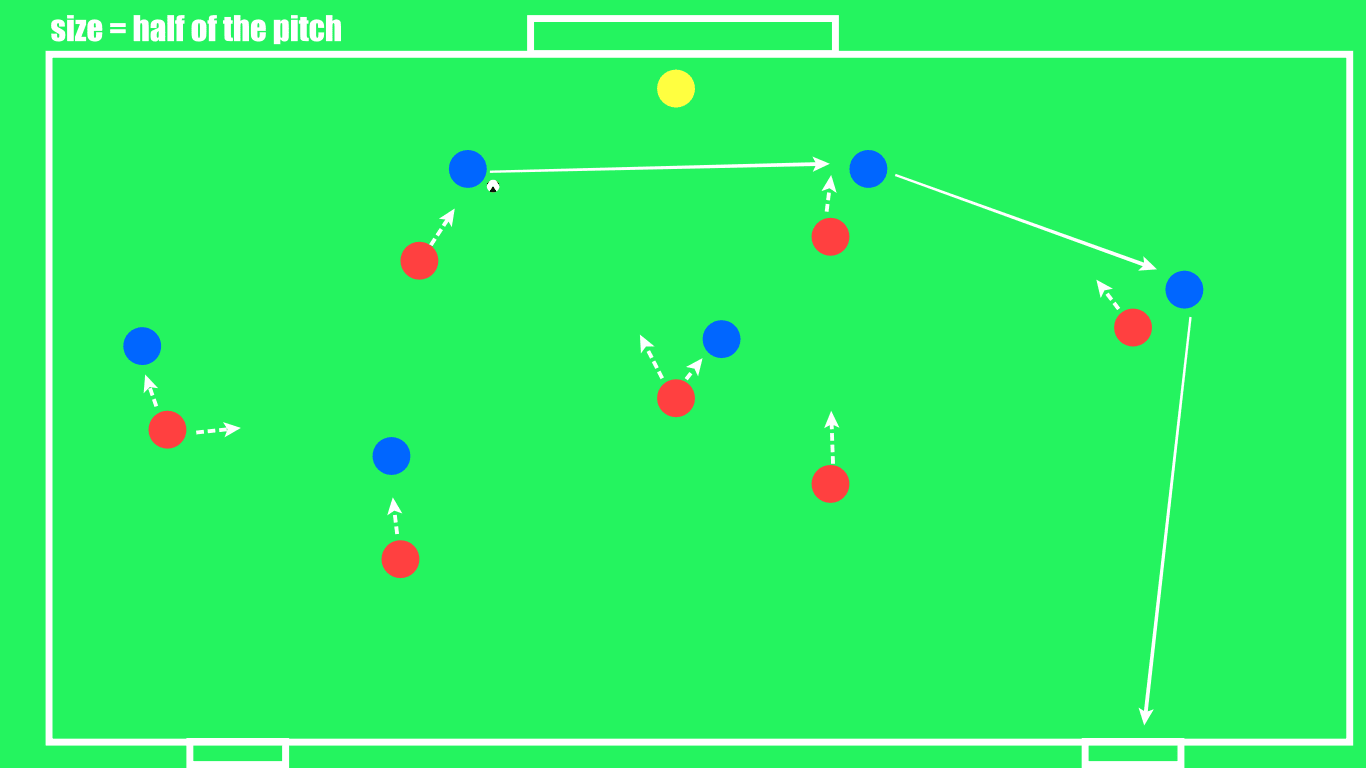
Numerical superior side of Reds has counter-pressing tasks when they lose the ball. They also need to keep their shape and protect the two goals, trying to regain possession in the shortest possible period. As in the previous exercises, the idea of control possession goes tightly with counter-press and it is important to base the coaching on these to together in order to get the best out of those sessions.
Conclusion
Control possession is one of the basic philosophies when it comes to dominating the pitch, and that said it needs to be trained with huge attention paid to details. The three drills shown in this coaching tactical analysis could help you teach your team play this way, but also how to accept the base knowledge in communication and the counter-pressing segment of the game.
The keys to successful control possession sessions, and after that successful control possession game and tactics, lay down in good decision-making, on-ball security and having solutions under pressure. Also, it is important for all the players to move properly, so all of the shown exercises are the mixture of the main factors that are included in this style of play.





Comments